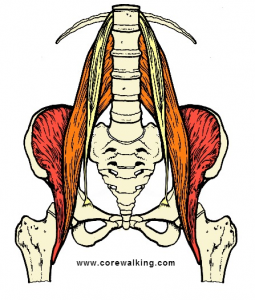 Anyone who has read this blog knows how enamored I am of psoas release work in general and constructive rest position in particular.
Anyone who has read this blog knows how enamored I am of psoas release work in general and constructive rest position in particular.
I have put up the video I have made on Constructive rest numerous times, so I thought it might be interesting to include several takes on this wonderful pose from different practitioners.
There are many different resources for the psoas, and releasing the psoas.
Constructive rest is a psoas release exercise created by Mabel Todd though her version has a different alignment than in the videos below.
An esoteric take on the psoas is that as a primitive muscle deep in the core of the body it is involved in all actions of the sympathetic nervous system functioning as a warehouse for many of our unprocessed emotions.
In addition, psoas dysfunction is often related to lower back pain.
The first video is my own. Constructive Rest as a psoas release is one of the essential resources offered in my CoreWalking Program.
One of the Core Four exercises, along with strengthening poses to build tone in the muscles that support the psoas, Constructive Rest is a release that allows gravity to have its way with a body on its back with the knees bent and the feet flat to the floor.
I encourage people to spend a long time, if it is available, in the pose.
In the service of psoas release it can sometimes take the body a long time to let go so a half hour, and even forty minutes or more, can sometimes serve us well.
Also I think that mixing and matching releases can be very effective, especially pairing constructive rest with Block Lunges if the quadriceps muscles are stubbornly full of tension.
Next up is my friend Brooke Thomas, Rolfer and yoga teacher with a great website and blog at Fascia Freedom Fighters.
Brooke takes a slightly different approach than I do, offering props like a pillow between the legs and a book under the head.
Third we have Ed Jarvis offering Constructive Rest from the perspective of the Alexander Technique.
Constructive rest is a popular pose in the Alexander Technique community.
His set up is different from mine with a less particular attention paid to the placement of the feet.
My take is that the feet and heels should be directly in line with the sit bones in order to create a less stable environment that encourages more movement and release.
Finally I’ll share a very powerful video presented without audio showing people doing the Trauma Release Exercise (TRE) work of David Berceli.
This is a wild video and I have to say that this variation of Constructive Rest boggles my mind.
I have done the pose this way and the tremors that are induced are very intense to experience.
Psoas release work can be some very deep letting go of long held trauma and it is my take that we are all traumatized to one degree or another. Such is the game of life.
The ability to process trauma differs from one person to the next and cultivating the ability to let go of some of the unprocessed energies that might still be housed within the body is well worth the patience and effort it entails.
The resources provided in these videos all differ slightly but are all meant to bring the body to a greater place of relaxation in the nervous system.
